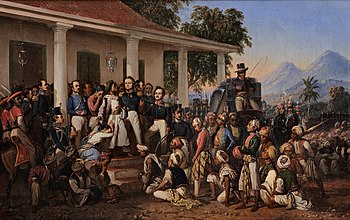The Arrest of Pangeran Diponegoro
| The Arrest of Pangeran Diponegoro | |
|---|---|
| Indonesian: Penangkapan Pangeran Diponegoro, Dutch: Gevangenname van Prins Diponegoro | |
 |
|
| Artist | Raden Saleh |
| Year | 1857 |
| Dimensions | 112 cm × 178 cm (44 in × 70 in) |
| Location | Istana Negara, Jakarta, Indonesia |
The Arrest of Pangeran Diponegoro (also The Arrest of Prince Diponegoro; Indonesian: Penangkapan Pangeran Diponegoro; Dutch: Gevangenname van Prins Diponegoro) is the name of an 1857 painting by Raden Saleh, depicting the capture of Prince Diponegoro by Lieutenant General Hendrik Merkus de Kock on 28 March 1830.
Prince Diponegoro stands, defiant, in front of Lieutenant General Hendrik Merkus de Kock in front of the colonial officer's mansion. He wears a green turban, white tabard over pantaloons, and a jacket; around his waist is a golden belt, to which prayer beads are attached, and over his shoulder is a shawl. He appears to be struggling to control his anger – as would be expected from Javanese gentry – while the Europeans' eyes are static and avoid the eyes of others.
De Kock, the captor, stands to Diponegoro's left, at the same level as the guerrilla. Further to the left are various Dutch officers, identified by the historian and Diponegoro biographer Peter Carey as Colonel Louis du Perr, Lieutenant-Colonel W.A. Roest, and Major-Adjutant Francois Victor Henri Antoine Ridder de Stuer. To the prince's right stands a Javanese man identified by Carey as Diponegoro's son, Diponegoro the Younger, followed by Resident of Kedu Franciscus Gerardus Valck, Major Johan Jacob Perié, and Captain Johan Jacob Roeps. At Diponegoro's feet, a woman – possibly his wife Raden Ayu Rětnaningsih – reaches out to grab him.
The view from the northeast shows a still morning scene, with no wind blowing, and centered around Diponegoro. Saleh gives the painting depth of field, showing the soldiers closest to the front in crisp detail, while blurring the details of those in the back rows. The heads of the Dutchmen depicted appear to be slightly too large for their bodies, while those of the Javanese soldiers are of proper proportions. The painter, Raden Saleh, inserted himself into the painting twice: as a soldier bowing to the captured leader, and as a soldier facing the viewer.
...
Wikipedia
